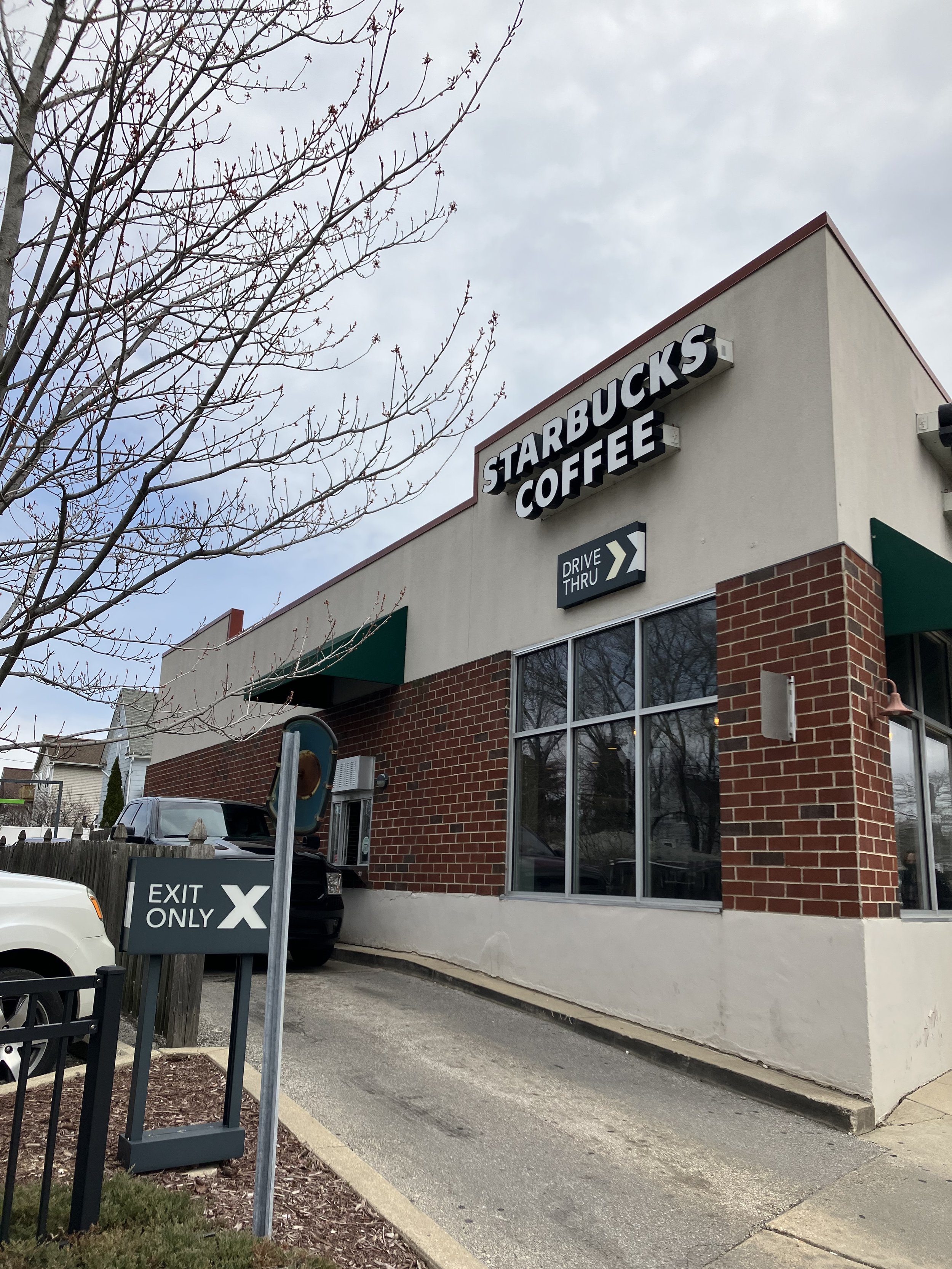Hey, Starbucks: Your Drive-Thru Doesn't Belong in My Community
(Source: Author.)
There is a Starbucks drive-thru three blocks from my house in a residential, but very much urban, neighborhood of Milwaukee, Wisconsin. And, for the last 11 months that I have lived here, it’s been slowly driving me insane. I walk past the coffee shop on my way to many neighborhood businesses, a local park, and my church. And each time, I get angrier.
Sometimes when I’m walking by the Starbucks, I take an extra long time to make my way across the drive-thru area, really enjoying forcing those cars to wait a few additional seconds to get their Vanilla Sweet Cream Cold Brew with Mocha Drizzle. It’s not because I have a particular vendetta against Starbucks as a business. Rest assured, I’ve had my fair share of Starbucks lattes in my day.
But this drive-thru business irks me, and it’s taken me a while to put my finger on exactly why.
Is it the fact that the cars are constantly blocking the sidewalk, the bike lane, and the street—and that drivers are largely oblivious to anyone crossing in front of them?
Is it the fact that there are three different road signs that Milwaukee residents’ tax dollars paid to install just to tell people they can’t make a U-turn into the drive-thru during morning rush hour?
(Source: Author.)
Or is it, maybe, the fact that there are not one, not two, but three locally-owned coffee shops all within a couple blocks of this Starbucks, none of which have more than a handful of people in line on a given day, and most of which have lower prices—so why do people have to patronize the busy, expensive chain?
Is it, perhaps, just the confusion I feel when I see a line of 10 cars all waiting for coffee at 4:30 p.m. (isn’t that kind of late in the day for caffeine)?
Maybe it’s just that I can’t understand why so many people can’t be bothered to get off their butts for mere minutes in order to procure their daily coffee, but must instead wait inside their climate-controlled vehicles, with no interaction between them and the store employees besides hearing a disembodied voice that says, “May I take your order?” and seeing a hand produce their Venti Honey Almond Milk Latte after they swipe their credit card?
But no, it wasn’t any of these things on their own that were driving me insane. What I realized recently is that I’m infuriated by the drive-thru because it is fundamentally not for me. Instead, it denotes my neighborhood as a place to, well, drive through—a place that doesn’t even merit stepping outside your vehicle for. Sure, there are probably some people in my neighborhood who stop at the Starbucks on their way to work, but this business is strategically located a few blocks from a highway exit and along a busy stroad. It was built for people passing through, so that they wouldn’t even have to exit their cars in order to get their daily Grande Caramel Frappuccino with Soy Milk.
Do you have a drive-thru fast food business in your neighborhood? If so, do you have the same feeling about it as I do? That this place is built so people outside your neighborhood can breeze through and never actually experience the place where you live?
Our communities should be places where people want to stay and spend time, not zip through at high speed. When we build our world around wide streets, parking lots, and drive-thru restaurants, we are communicating the message that fast car traffic is more important than children walking to school, than local businesses trying to make a profit, than families biking to the park, than homeowners trying to live on safe and quiet streets… The list goes on. By building this drive-thru business in my neighborhood, the priority is clear: a multinational business making quick money and a stream of cars speeding through to give them that money.
(Source: Facebook / SmallPie.)
Two blocks away from this Starbucks is a very special neighborhood café that stands in stark contrast to the drive-thru. When we bought our house, the number one thing our Milwaukee friends remarked about the home was: “That’s right near SmallPie!”
SmallPie lives on an oddly shaped triangle of land between a few neighborhood streets in a cute historic building. Every day, it serves up amazing pies, coffee, and other drinks, plus a modest breakfast and lunch menu (sandwiches, salads, that sort of thing). And every day, it’s busy with couples on dates, families with kids in tow, friends meeting up, and dogs hanging out.
Based on the number of bikes, scooters, and strollers on the premises, the lack of cars (there’s no parking lot for this business) and my anecdotal observations, I’d be willing to bet that at least 60% of the people who patronize SmallPie come from the surrounding neighborhood and walked or biked to get there. For $2.25, you can get a cup of coffee, and for $8 you can get a delicious, filling piece of gourmet pie. Best of all, you can sit outside on the ample patio space, enjoying the sun, saying hi to neighbors, and watching the world go by. It’s a classic “third place”—a neighborhood gathering spot that exists outside of the home or work, where people can interact and meet one another.
Where Starbucks is solely focused on cycling customers through as quickly as possible, handing them their drinks and taking their hard-earned dollars in return, SmallPie is focused on being a delightful space for people to spend time together while enjoying tasty food and drink. (And by the way, they do a roaring trade in it. The restaurant group that runs this café and a few others is one of the most well known and successful in town, also offering catering of their pies and desserts to events and wholesaling to other local businesses.)
SmallPie took an old auto-body shop which had been previously vacant for many years and turned it into a flourishing community establishment. Starbucks cluttered up an otherwise pleasant corner with a constant flow of idling cars, adding nothing to the neighborhood except exhaust fumes.
SmallPie gets people out in their neighborhood and keeps money in our local economy. Starbucks keeps people in their cars and siphons money out of our community.
Drive-thrus don’t belong in my neighborhood or anyone else’s. And they certainly don’t belong in a strong town.







Rachel Quednau serves as Director of Movement Building at Strong Towns. Trained in dialogue facilitation and mediation, she is devoted to building understanding across lines of difference. Rachel has served in several different positions with Strong Towns over the years, as well as worked for local and federal housing organizations. A native Minnesotan and honorary Wisconsinite, Rachel attend Whitman College for her undergraduate and received a Masters in Religion, Ethics, and Politics from Harvard Divinity School. She currently lives in Milwaukee, Wisconsin, with her husband and two young children. One of her favorite ways to get to know a new city is by going for a walk in it.